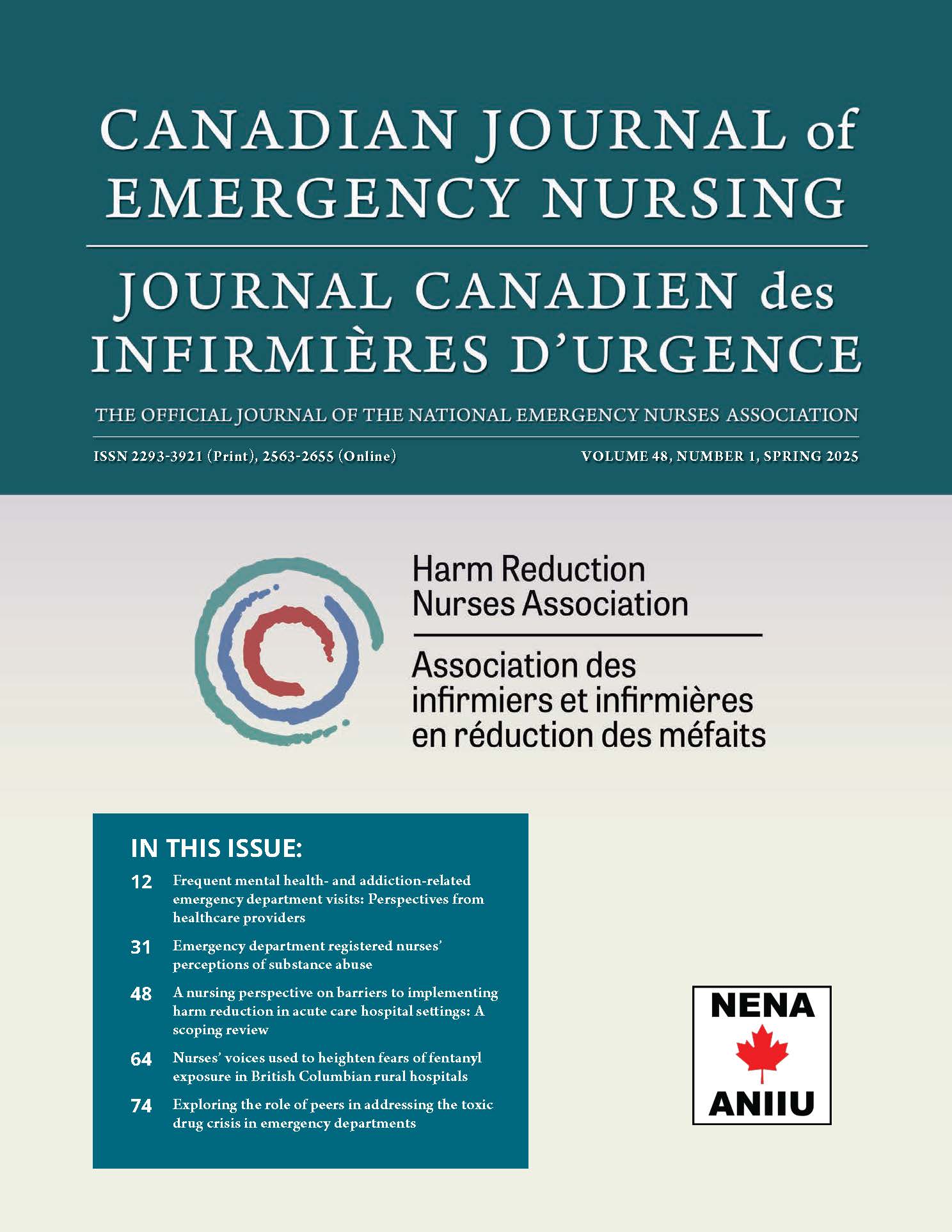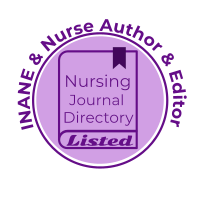A nursing perspective on barriers to implementing harm reduction in acute care hospital settings: A scoping review
DOI:
https://doi.org/10.29173/cjen240Abstract
Harm reduction strategies focusing on substance use have been largely implemented in communities. However, it has been underutilized in managing in-patient environments. When patients with substance use disorder (SUD) are hospitalized, without harm reduction management, they may engage in risky behaviours, leading to unsafe opioid use. Negative encounters with the healthcare system and discriminatory attitudes towards patients with SUD by healthcare professionals also contribute to health issues and safety concerns. This study reviewed existing literature on barriers to implementing harm reduction strategies in acute care hospitals. Three databases were searched for peer-reviewed articles published from 2014 to 2024. After screening 987 articles, ten met the inclusion criteria. The findings highlighted challenges nurses and patients encounter in implementing harm reduction in acute care hospitals, including stigma, safety concerns, educational gaps, and clinician burnout. Addressing these challenges entails nurse education and organizational changes. While the current research provides some insights, further studies should examine standardizing care plans for individuals with SUD, healthcare agencies' roles in promoting harm reduction education, and nurses' perspectives to enhance harm reduction strategies in in-patient settings.
Keywords: nurses, substance use disorder, in-patient, harm reduction
References
Antill Keener, T., Tallerico, J., Harvath, R., Cartwright-Stroupe, L., Shafique, S., &
Piamjariyakul, U. (2023). Nurses' Perception of Caring for Patients with Substance Use Disorder. Journal of Addictions Nursing, 34(2), 111–120. https://doi.org/10.1097/JAN.0000000000000523
Arksey, H., & O’Malley, L. (2005). Scoping studies: towards a methodological framework.
International Journal of Social Research Methodology, 8(1), 19–32. https://doi.org/10.1080/1364557032000119616
Bentley, S. M. (2010). Nursing retention through addressing burnout. Nursing Management,
41(12), 19–21. https://doi.org/10.1097/01.NUMA.0000390467.13410.d4
Bleazard, M. (2020). Compassion fatigue in nurses caring for medically complex
children. Journal of Hospice & Palliative Nursing, 22(6), 473–478. https://doi.org/10.1097/NJH.0000000000000688
Boyle, D. A. (2011). Countering compassion fatigue: a requisite nursing agenda. Online Journal
of Issues in Nursing, 16(1), 2–2. https://doi.org/10.3912/ojin.vol16no01man02
Chappel, J. N., Veach, T. L., & Krug, R. S. (1985). The substance abuse attitude survey: An
instrument for measuring attitudes. Journal of Studies on Alcohol, 46(1), 48–52. https://doi.org/10.15288/jsa.1985.46.48
Copeland, D. (2021). Brief Workplace Interventions Addressing Burnout, Compassion Fatigue,
and Teamwork: A Pilot Study. Western Journal of Nursing Research, 43(2), 130–137. https://doi.org/10.1177/0193945920938048
Dion, K., Choi, J., & Griggs, S. (2023). Nursing Students' Use of Harm Reduction in the Clinical
Setting. Nurse Educator, 48(2), 82–87. https://doi.org/10.1097/NNE.0000000000001307
Dion, K., & Griggs, S. (2020). Teaching Those Who Care How to Care for a Person With
Substance Use Disorder. Nurse Educator, 45(6), 321–325. https://doi.org/10.1097/NNE.0000000000000808
Government of Canada. (2023). Territorial Special Advisory Committee on the Epidemic of
Opioid Overdoses. Opioid-and stimulant-related harms in Canada. Ottawa (ON): Public Health Agency of Canada.
Grewal, H. K., Ti, L., Hayashi, K., Dobrer, S., Wood, E., & Kerr, T. (2015). Illicit drug use in
Acute care settings. Drug and Alcohol Review, 34(5), 499–502. https://doi.org/10.1111/dar.12270
Grove, S.K., & Gray, J. R. (2019). Building an evidence-based nursing practice. In S. K. Grove
& J. R. Gray (Eds.), Understanding nursing research: Building an evidence-based practice (7th ed., pp. 119–164). Elsevier.
Harling, M. R. (2017). Comparisons between the attitudes of student nurses and other health and
social care students toward illicit drug use: An attitudinal survey. Nurse Education Today, pp. 48, 153–159. https://doi.org/10.1016/j.nedt.2016.10.012
Hopson, M., Petri, L., & Kufera, J. (2018). A New Perspective on Nursing Retention: Job
Embeddedness in Acute Care Nurses. Journal for Nurses in Professional Development, 34(1), 31–37. https://doi.org/10.1097/NND.0000000000000420
Horner, G., Daddona, J., Burke, D. J., Cullinane, J., Skeer, M., & Wurcel, A. G. (2019). "You're
kind of at war with yourself as a nurse": Perspectives of inpatient nurses on treating people who present with a comorbid opioid use disorder. PloS One, 14(10), e0224335. https://doi.org/10.1371/journal.pone.0224335
International Harm Reduction Association. (2024). Global state of harm reduction 2024: Key
issues and challenges. International Harm Reduction Association.
Neville, K., & Roan, N. (2014). Challenges in Nursing Practice. The Journal of Nursing
Administration, 44(6), 339–346. https://doi.org/10.1097/NNA.0000000000000079
Nolan, S., Kelian, S., Kerr, T., Young, S., Malmgren, I., Ghafari, C., Harrison, S., Wood, E.,
Lysyshyn, M., & Holliday, E. (2022). Harm reduction in the hospital: An overdose prevention site (OPS) at a Canadian hospital. Drug and Alcohol Dependence, p. 239, 109608. https://doi.org/10.1016/j.drugalcdep.2022.109608
Pauly, B., McCall, J., Browne, A. J., Parker, J., & Mollison, A. (2015). Toward Cultural Safety:
Nurse and Patient Perceptions of Illicit Substance Use in a Hospitalized Setting. Advances in Nursing Science, 38(2), 121–135. https://doi.org/10.1097/ANS.0000000000000070
Perera, R., Stephan, L., Appa, A., Giuliano, R., Hoffman, R., Lum, P., & Martin, M. (2022).
Meeting people where they are: implementing hospital-based substance use harm reduction. Harm Reduction Journal, 19(1), 14–14. https://doi.org/10.1186/s12954-022-00594-9
Slatten, L. A., Carson, K. D., & Carson, P. P. (2020). Compassion fatigue and burnout: what
managers should know. The health care manager, 39(4), 181-189.
Wolotira, E. A. (2023). Trauma, compassion fatigue, and burnout in nurses: The Nurse Leader’s
response. Nurse Leader, 21(2), 202-206. https://doi.org/10.1016/j.mnl.2022.04.009
Published
How to Cite
Issue
Section
License
Copyright (c) 2025 Kaitlyn Furlong, Hua Li, Jodie Bigalky

This work is licensed under a Creative Commons Attribution 4.0 International License.
The Canadian Journal of Emergency Nursing is published Open Access under a Creative Commons CC-BY 4.0 license. Authors retain full copyright.




